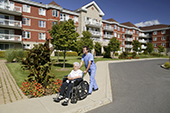-
- Nursing homes provide skilled care to disabled and vulnerable populations.
Nursing homes provide room and board, on-site nursing care, supervision, and personal assistance to people who are unable to care for themselves. Nursing homes are part of a network of long-term services and support—other services include home- and community-based services and home health care. In California, nursing homes are licensed by the California Department of Public Health. At the end of 2014, there were 1,220 licensed nursing homes operating statewide. - Costs for most nursing home patients are covered by Medi-Cal.
Nursing home care is the most costly residential care option; in 2014 the average annual cost of each bed was approximately $90,000 for a semi-private room and $104,000 for a private room. California’s nursing facilities had an occupancy rate of 85.4%—119,696 beds with 102,175 patients—at the end of 2014. More than 59% of these patients were covered by Medi-Cal (California’s Medicaid program), and more than 14% were covered by Medicare. Medi-Cal payments for nursing home patients are based on facility-specific, cost-based reimbursement rates determined by the Department of Health Care Services. In 2014, total Medi-Cal costs for nursing home care were $4.5 billion, or 30.4% of all long-term care services covered by Medi-Cal. - Shifting nursing home demographics reflect changes in California’s senior population.
While nursing homes serve patients of all ages, the vast majority are seniors. In 2014, 80.5% of nursing home patients were over the age of 65. As the racial distribution of Californians over the age of 65 changes, so too does the racial composition of nursing home patients. The percentage of patients who are white has declined by 11.1% since 2004 (to 58.2%); while the shares of Asian patients and those of other or unknown races have increased by 3.3% and 6.6% (to 11.3% and 18.8%). Over the same period, the share of Hispanic patients has increased from 13.3% to 18.4%.
- Nursing homes provide skilled care to disabled and vulnerable populations.
California nursing home patients are becoming more diverse

SOURCE: Office of Statewide Health Planning and Development (OSHPD) facility level files for long-term care facilities (2014).
NOTE: Based on the share of patients of each racial/ethnic group as of December 31 of the reporting year. Shares for whites, blacks, Asians, and other/unknown may include those of Hispanic origin, while those categorized as Hispanic may be of any race.
-
- Most nursing home stays are short term.
Many people need nursing home care only for short periods—for example, while they recover from surgery or illness. State data suggests that short-term stays are more common than long-term stays. About one-third (34.2%) of stays are no more than two weeks, half (49.4%) are between two weeks and three months, and the remaining 16.4% are longer than three months. - California has a larger share of highly rated nursing homes than the rest of the nation.
According to the federal Center for Medicare and Medicaid Services—which rates federally certified nursing homes on a five-star scale—California has a large number of high-quality nursing homes. Based on health inspections, nurse staffing hours, and other quality measures, these ratings provide a way for users to compare quality of care across facilities. In 2015, 56.5% of nursing homes in California received high overall ratings (four or five stars); compared to a national average of 46.4%. Low ratings (one or two stars) were given to 27.4% of nursing homes in California, compared to 34.6% nationally. The supply of highly rated nursing homes varies across regions—the highest share is in the Sacramento area (72.4%), and the lowest is in the Northern and Sierra area (24.6%).
- Most nursing home stays are short term.
The quality of California nursing homes varies across regions

SOURCE: Centers for Medicare and Medicaid Services (CMS) Nursing Home Compare files (July 2015).
NOTES: High-quality nursing homes are those with an overall CMS rating of four or five; medium-quality have a CMS rating of three; and low-quality have a rating of one or two. Central Coast: Monterey, San Benito, San Luis Obispo, Santa Barbara, Santa Cruz, and Ventura. Greater Bay Area: Alameda, Contra Costa, Marin, Napa, San Francisco, San Mateo, Santa Clara, Solano, and Sonoma. Inland Empire: Riverside and San Bernardino. Northern and Sierra: Amador, Butte, Calaveras, Colusa, Del Norte, Glenn, Humboldt, Inyo, Lake, Lassen, Mariposa, Mendocino, Modoc, Nevada, Plumas, Shasta, Sierra, Siskiyou, Sutter, Tehama, Trinity, Tuolumne, and Yuba. Sacramento area: El Dorado, Placer, Sacramento, and Yolo. San Joaquin Valley: Fresno, Kern, Kings, Madera, Merced, San Joaquin, Stanislaus, and Tulare.
- Nursing homes could be better coordinated with other long-term support services.
Research indicates that some senior and disabled Californians can avoid or put off going into nursing homes by participating in programs such as In-Home Support Services (IHSS), which allows Medi-Cal beneficiaries to hire caregivers who help them with daily tasks and activities. The legislature is working to improve the state’s long-term support network so that it serves seniors more effectively.
Sources: Office of Statewide Health Planning & Development Long-Term Care Facilities, 2014 Final Database, Center for Medicare & Medicaid Services Nursing Home Compare Files (July 2015, and Q4 2014), Kaiser Family Foundation tables on long-term care spending, Newcomer et al., Extended Nursing Facility Stays Among California’s Dual Eligible and Medi-Cal-Only Beneficiaries, 2006-2008 (2013), Genworth 2015 Cost of Care Survey.
Topics
Health & Safety Net Population

